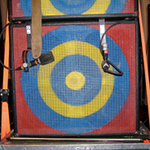Matthew Israel: CAA Book Author Interview
This is the second in a series of short interviews with the authors of The Eye, the Hand, the Mind: 100 Years of the College Art Association, a book edited by Susan Ball and published in conjunction with CAA’s Centennial.
Matthew Israel
Matthew Israel is an art historian (PhD, Institute of Fine Arts, New York University) who has taught modern and contemporary art history as well as critical reading and writing at New York University, Parsons the New School for Design, and the Museum of Modern Art. He has written for Art in America, Artforum, and Frieze and contributed to books and catalogues for the Whitney Museum of American Art, the New Museum of Contemporary Art, Gagosian Gallery, Cheim and Read Gallery, and Marianne Boesky Gallery. He is currently working on Paradigms of Protest, a book concerning American artists’ protest of the Vietnam War (forthcoming from University of Texas Press).
Israel’s chapter on “CAA, Pedagogy and Curriculum: A Historical Effort, an Unparalleled Wealth of Ideas” considers how the organization’s journals, research initiatives, and conference programming reflect its varying commitments to teaching.
What was the most surprising thing that you learned about CAA during your research and writing?
Primarily, that concerns regarding pedagogy and curriculum were the principal reasons for CAA’s founding. Also, I didn’t anticipate that the organization, even dating back to the early years of CAA (1917 in fact), has been struggling with how much time it should devote to issues of pedagogy and curriculum in art history and studio art and how much time should be spent supporting “technical” research (i.e., art-historical scholarship).
Moreover, I was intrigued by how CAA consistently aimed, throughout its history, to create publications that would rival more mainstream magazines such as ARTnews, Art Digest, or Art in America.
I was also interested in CAA’s very short-lived Research Institute of Fine Arts, which was founded in the early 1930s and sought to support the art-historical research of two fellows, at what CAA described then as “the most favorable conditions possible.” (The fellows would, importantly, use their research to train young art historians in the field, especially those from colleges outside New York.) The program lasted only one year.
How has your work on the book changed your perception of the organization?
In brief, it has made me immensely appreciative of what CAA has done for art education in the United States.
What were the watershed moments in the areas that you investigated? What do you want readers to take away from your chapter?
There were two watershed moments in CAA’s engagement with pedagogy and curriculum—specifically two CAA publications—and I would highly encourage anyone interested in the subject to read them. The first was Robert Goldwater’s landmark 1943 survey, “The Teaching of Art in the Colleges of the United States,” which gave a broad yet detailed explanation of the current state of art as the subject of academic study in American liberal-arts colleges. CAA published it as a supplement to Art Journal in May 1943. Goldwater’s report was, and still is, incredibly significant for the field,because it offered arguably the best—and also perhaps the sole—overview of art in the academic context during this period.
The second watershed moment was CAA’s publication, with Yale University Press, of The Visual Arts in Higher Education (1966). In general, this book-length study considered Goldwater’s previous report as a departure point and sought to outline in much greater depth the character of American art history and studio art. It also describes the organization’s particular recommendations for the fields “just twenty-three years after” Goldwater’s breaking ground (a statement which made self-deprecating fun of CAA’s historical delay in following up Goldwater’s work). No similar study has been attempted since.
How should CAA move forward into the next one hundred years? What has the organization addressed well, and what unexplored territories or constituencies should it begin to explore?
I would like to see CAA increase its involvement with issues of pedagogy and curriculum. Even though the implicit attitude among those in the field is that CAA should take a minimal role in this area—and leave such work to individual departments and professors—departments do not characteristically end up engaging these issues as much as they could. Thus, we are currently encouraging the creation of—and I can only truly speak about art history—instruction not primarily concerned with educating others, but which is predominantly about the professor’s personal academic work. This, in turn, encourages others to do the same. As such, I feel we are putting ourselves at risk of losing the idea of education where the central focus is the generous giving of oneself and one’s knowledge to (and for) the future.
Originally published on the CAA website on April 27, 2011.
